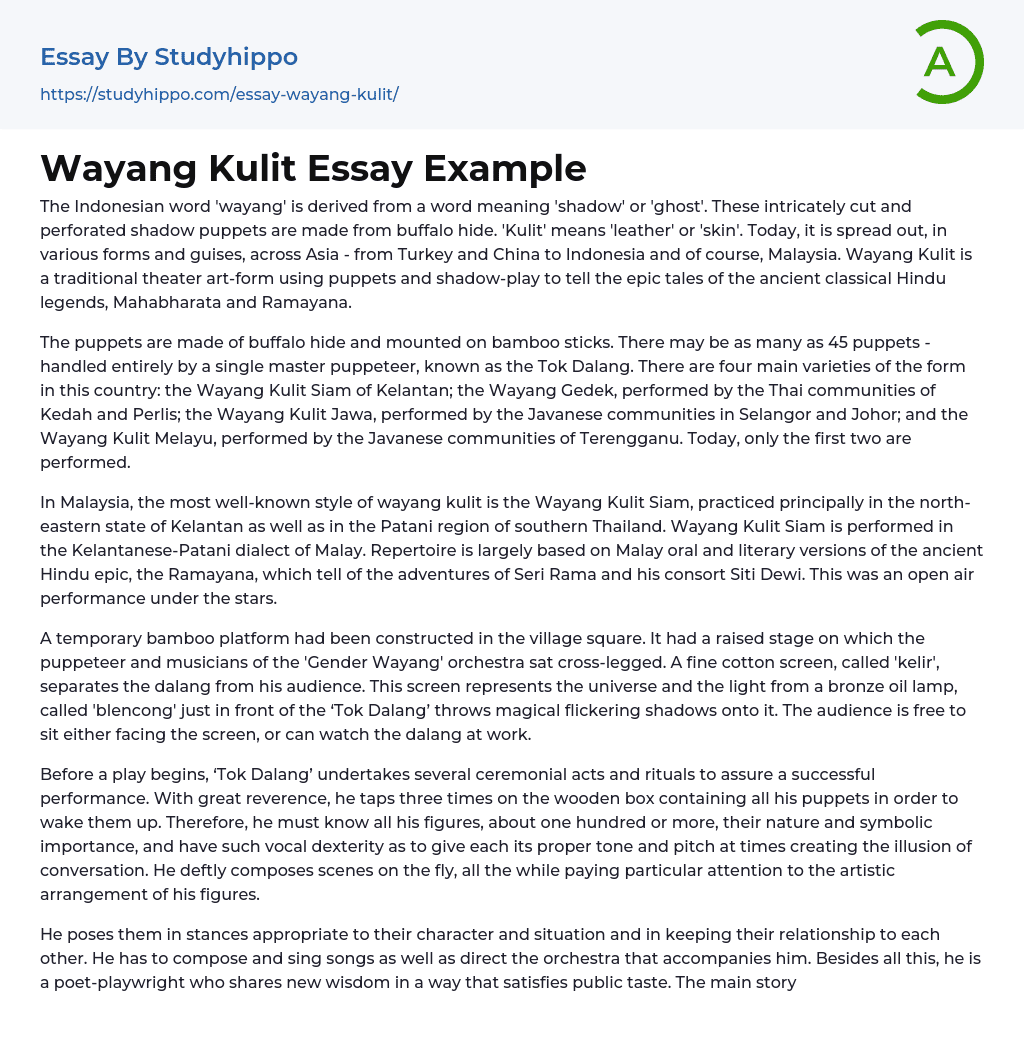The Indonesian word 'wayang' is derived from a word meaning 'shadow' or 'ghost'. These intricately cut and perforated shadow puppets are made from buffalo hide. 'Kulit' means 'leather' or 'skin'. Today, it is spread out, in various forms and guises, across Asia - from Turkey and China to Indonesia and of course, Malaysia. Wayang Kulit is a traditional theater art-form using puppets and shadow-play to tell the epic tales of the ancient classical Hindu legends, Mahabharata and Ramayana.
The puppets are made of buffalo hide and mounted on bamboo sticks. There may be as many as 45 puppets - handled entirely by a single master puppeteer, known as the Tok Dalang. There are four main varieties of the form in this country: the Wayang Kulit Siam of Kelantan; the Wayang Gedek, performed by the Thai communities of Kedah and Perlis; the W
...ayang Kulit Jawa, performed by the Javanese communities in Selangor and Johor; and the Wayang Kulit Melayu, performed by the Javanese communities of Terengganu. Today, only the first two are performed.
In Malaysia, the most well-known style of wayang kulit is the Wayang Kulit Siam, practiced principally in the north-eastern state of Kelantan as well as in the Patani region of southern Thailand. Wayang Kulit Siam is performed in the Kelantanese-Patani dialect of Malay. Repertoire is largely based on Malay oral and literary versions of the ancient Hindu epic, the Ramayana, which tell of the adventures of Seri Rama and his consort Siti Dewi. This was an open air performance under the stars.
A temporary bamboo platform had been constructed in the village square. It had a raised stage on which the puppeteer and musicians of th
'Gender Wayang' orchestra sat cross-legged. A fine cotton screen, called 'kelir', separates the dalang from his audience. This screen represents the universe and the light from a bronze oil lamp, called 'blencong' just in front of the ‘Tok Dalang’ throws magical flickering shadows onto it. The audience is free to sit either facing the screen, or can watch the dalang at work.
Before a play begins, ‘Tok Dalang’ undertakes several ceremonial acts and rituals to assure a successful performance. With great reverence, he taps three times on the wooden box containing all his puppets in order to wake them up. Therefore, he must know all his figures, about one hundred or more, their nature and symbolic importance, and have such vocal dexterity as to give each its proper tone and pitch at times creating the illusion of conversation. He deftly composes scenes on the fly, all the while paying particular attention to the artistic arrangement of his figures.
He poses them in stances appropriate to their character and situation and in keeping their relationship to each other. He has to compose and sing songs as well as direct the orchestra that accompanies him. Besides all this, he is a poet-playwright who shares new wisdom in a way that satisfies public taste. The main story-line, known as cerita pokok (trunk story), is performed occasionally; minor-tales and sub-plots involving the same characters, known as cerita ranting (branch stories), are far more popular. The principal performer in the Wayang Kulit Siam tradition is the dalang (master uppeteer).
Besides animating the puppets with action and speech, ‘Tok Dalang’ provides narration and commentary, leads the musical orchestra and attends to the ritual aspects
of a performance. Wayang Kulit Siam puppets are intricately carved and vibrantly painted two-dimensional figures made from leather. The format on playing wayang kulit contains lots of entertainment and education essence in it base on stories from the old folks and legend. Ritual performance, puppets movement, speech, songs, background music, and visual are all important elements in the playing format for the performance.
As a solo actor, ‘Tok Dalang’ plays a lot of character in a single show, acting as part of the story, dialogue, singing and as a group leader in the show. Therefore, there is a fixed speech, fixed movement, fixed storyline and fixed character in a wayang kulit plays which becomes a guideline to control the self improvisation by the ‘Tok Dalang’. ‘Tok Dalang’ is the only actor in the play, does not interact with other actors but only interacts with him alone. The guided ‘Tok Dalang’ techniques still being followed and pass down from generation to generation until today.
- Java essays
- Object-Oriented Programming essays
- John Locke essays
- 9/11 essays
- A Good Teacher essays
- A Healthy Diet essays
- A Modest Proposal essays
- A&P essays
- Academic Achievement essays
- Achievement essays
- Achieving goals essays
- Admission essays
- Advantages And Disadvantages Of Internet essays
- Alcoholic drinks essays
- Ammonia essays
- Analytical essays
- Ancient Olympic Games essays
- APA essays
- Arabian Peninsula essays
- Argument essays
- Argumentative essays
- Art essays
- Atlantic Ocean essays
- Auto-ethnography essays
- Autobiography essays
- Ballad essays
- Batman essays
- Binge Eating essays
- Black Power Movement essays
- Blogger essays
- Body Mass Index essays
- Book I Want a Wife essays
- Boycott essays
- Breastfeeding essays
- Bulimia Nervosa essays
- Business essays
- Business Process essays
- Canterbury essays
- Carbonate essays
- Catalina de Erauso essays
- Cause and Effect essays
- Cesar Chavez essays
- Character Analysis essays
- Chemical Compound essays
- Chemical Element essays
- Chemical Substance essays
- Cherokee essays
- Cherry essays
- Childhood Obesity essays
- Chlorine essays




